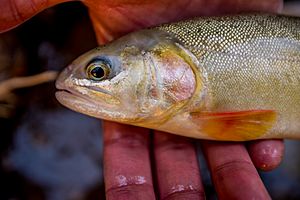Gila trout facts for kids
Quick facts for kids Gila trout |
|
|---|---|
 |
|
| Conservation status | |
| Scientific classification | |
| Genus: |
Oncorhynchus
|
| Species: |
gilae
|
The Gila trout (Oncorhynchus gilae) is a type of salmonid fish, like the rainbow trout. It lives naturally in the Southwest United States. Before 2006, the Gila trout was listed as an endangered animal. This meant it was in danger of disappearing forever.
In July 2006, after a lot of hard work by wildlife groups, the Gila trout's status improved. It was changed to "threatened". This means it's still at risk, but less so than before. For the first time in almost 50 years, people can now fish for them in a very limited way. When fishing for Gila trout was stopped in the 1950s, there were very few left. As of 2011, you can fish for this copper-colored trout in both New Mexico and Arizona.
Contents
Where Gila Trout Live
The Gila trout naturally lives in smaller rivers and streams that flow into the Gila River. These areas are found in Arizona and New Mexico. Historically, they also lived in the Verde and Agua Fria river systems in Arizona. Natural barriers, like waterfalls, stopped them from going into other areas.
Today, Gila trout are still found in five streams within the Gila National Forest in New Mexico. These include Iron, McKenna, and Spruce creeks in the Gila Wilderness Area. They also live in Main and South Diamond creeks in the Aldo Leopold Wilderness Area.
What Gila Trout Look Like
Gila trout have a yellow body with black spots. They usually grow to be about 30 centimeters (about 12 inches) long. The biggest ones can reach around 55 centimeters (about 22 inches).
Gila trout are very similar to Apache trout. However, you can tell them apart by their spots. Apache trout often have spots near their eyes and big, easy-to-see spots on their bodies. Gila trout, on the other hand, have many small, dark spots mostly on the top half of their bodies.
Gila Trout Biology
Gila trout prefer to live in small mountain streams. They can also be found in deep, calm pools of water. They are not picky eaters and will eat what they can find. Their diet mainly includes aquatic insects. These insects can be caddisflies, mayflies, midges, and beetles. Sometimes, they also eat small fish.
Reproduction and Life Cycle
The time when Gila trout lay their eggs depends on how warm the water is. This usually happens in late spring and summer. Female Gila trout in special fish hatcheries produce about 150 eggs on average. Some females have been known to lay as many as 686 eggs.
Protecting Gila Trout
The Gila trout has faced many challenges. One problem is competition from other fish that have been brought into their waters, like rainbow trout. These new fish also sometimes breed with Gila trout, which can make the pure Gila trout less common.
However, the biggest threat to Gila trout has been the loss of their habitat. This happens when streams lose water flow or shade from trees. Causes include wildfires, humans destroying plants along the riverbanks, and too much grazing by livestock. Farmers also divert water for irrigation, and streams are sometimes changed for human use.
By 1967, when the U.S. Fish and Wildlife Service listed the Gila trout, their living area had shrunk a lot. From hundreds of miles of streams, they were only found in about 20 miles within the Gila Wilderness and Aldo Leopold Wilderness.
After the listing, the U.S. Fish and Wildlife Service started a big program to help. They removed introduced trout and worked to restore the plants along the riverbanks. This helps keep the water cooler, which trout need. They also restocked streams with young Gila trout. The Mora National Fish Hatchery and Technology Center in New Mexico raises Gila trout for this purpose.
Today, the Gila trout is safer than it was in the 1970s. They have been moved to 10 new streams. However, their numbers and habitat are still much smaller than they used to be. Conservationists hope to eventually remove the species from the threatened list. They also want to work with fishermen to help protect these special fish. Big wildfires and dry periods will always be a challenge for any trout species.
See also
 In Spanish: Trucha de Gila para niños
In Spanish: Trucha de Gila para niños
Images for kids
Froese, Rainer, and Daniel Pauly, eds. (2005). "Oncorhynchus gilae" in FishBase. 10 2005 version.





